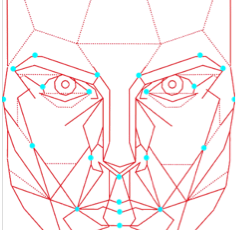Every once in a while I get a flash of inspiration and convince myself that I am a visionary, a prophet with a window into the next big thing, Ultimately the feeling comes crashing to the ground as I discover that my brainchild may have been brilliant, but it was not new. Credit card payment at the fuel pumps, traffic lights that change for oncoming emergency vehicles, and the squeezable ketchup bottle. All of them my ideas, coming just mere months after having been introduced to the world. I am proud to say that this trend continues, with the introduction of facial biometrics.
In the Spielberg film Minority Report, retailers used facial recognition to identify Tom Cruise’s character and employed it to display appropriate ads as he is being chased through a mall. Eleven years later, and the technology is on the verge of becoming main stream.
In its simplest form, consumers may have used facial biometrics for the purposes of securely signing onto their PC’s, or in managing their digital photo collection, grouping photos by facial characteristics. Retailers are now taking advantage of those same capabilities, and are implementing facial biometrics programs to help reduce costs and increase sales.
The technology is quite simple... on paper. A camera detects the presence of a face as it enters the store. Sophisticated algorithms map the details, and record it. Much like finger print detection, that map enables the software to identify your face whenever it is digitally captured. Wearing a hat or sunglasses won’t fool it.
The next time you enter a Chico’s, or a Canadian Tire, be sure to look up, and smile. That’s the way you’ll probably want to be remembered.
These chains have partnered with a company called 3VR and have begun using its Video Surveillance Program.The complete range of applications for FR may take years to fully reveal itself, but when it does, it will be paradigm shifting. It will forever more change the face of retailing (Pun well intended)
Here are a few of the existing apps available today and a few that I believe are just around the corner. Check out 3VR and NEC IT Solutions for more details.
Facial Biometric Applications
Maintain a file of shoplifters and identify them as they enter any store in the chain
The industry could maintain a common data base of shoplifters and the thief could be identified anytime they enter ANY store.
Highlight shoppers by nervous characteristics in their facial expression that might indicate possible criminal activity. This is a technique already being used in counter terrorism technology
Surveillance of the parking lot can identify the shoplifter if they are identified after they leave the store, and record the license plate number.
Electronic people counters at the door merely count the number of bodies moving in or out. More information is required to make it useful. With advanced facial recognition algorithms, a retailer could learn:
- gender
- estimated age
- frequency of return trips
- time spent in the store
- who might have accompanied them
By placing cameras throughout the store, it could determine
- highest traffic areas
- time a shopper stays in an area
- average time a shopper waits in line, at a specific part of the day
- areas of LOW traffic
- areas of the store most prone to shoplifting
CRM data can be gathered without requiring a loyalty card, or store account. It could maintain, for a specific customer, a database of purchases, and offer promotions as they walked through the store or at POS. Is the same person consistently requesting returns or getting POS markdowns? Identify high value clientele (celebrities) and give them extra special attention.
Benefits of the Technology
- More efficient use of sales associate time, handling priority clients
- Reductions in shrinkage
- Better scheduling of staff
- Improved shopping experience for repeat customers
- Efficient store design
- Placement of key items in the store in known traffic areas.
Early Adopters
- Chico’s
- Canadian Tire
- T-Mobile
Barriers to Adoption
Cost of equipment and software
There will no doubt be questions of privacy infringements. Retailers routinely photograph their shoppers, but can they keep a record of them along with other data? And can they share it with other retailers? And is it OK to capture facial data outside the store?
Verdict
I believe facial recognition is real, and will be a mainstream technology in the next 5-10 years, assuming privacy infringement laws don’t kill it first… or I think of something better!

